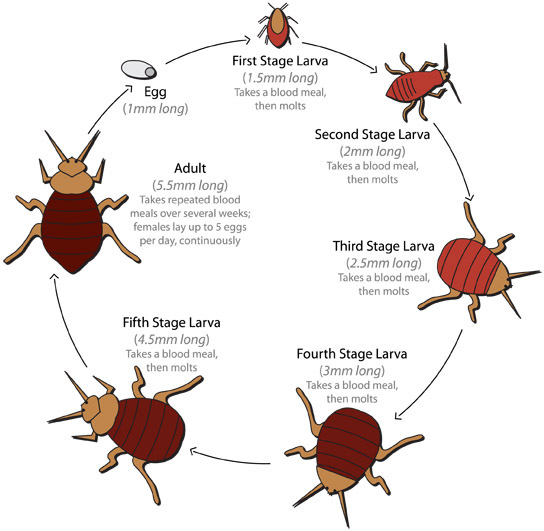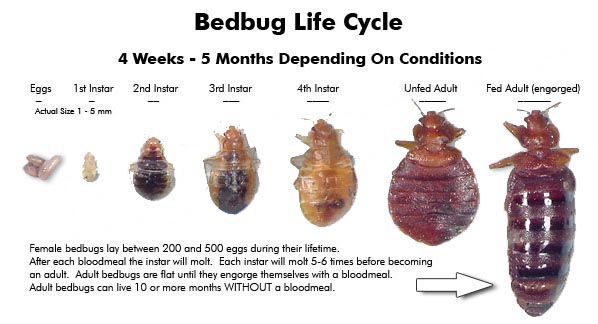What are Bed Bugs?
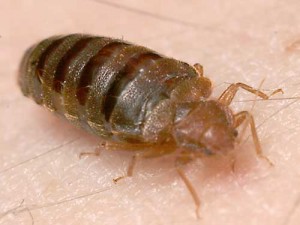 Cimex Lectulariusis is more commonly known as the 'Bed Bug' because of it's habit of hiding in beds and bedding and feasting on the blood of humans sleeping in them!
Cimex Lectulariusis is more commonly known as the 'Bed Bug' because of it's habit of hiding in beds and bedding and feasting on the blood of humans sleeping in them!
Cimex Lectulariusis is a parasite that usually hides away during the hours of daylight emerging just before dawn to feed on the blood of it's sleeping hosts - human beings - when they are in their deepest sleep.
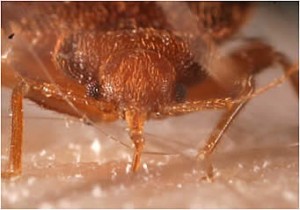 When Bed bugs can't feed on there preferred victims – humans, they will attack your pets in order to stay alive. Ask us now about a protocol that actually keeps your pets away from bed bugs thus helping to prevent their population from expanding exponentially in your home.
When Bed bugs can't feed on there preferred victims – humans, they will attack your pets in order to stay alive. Ask us now about a protocol that actually keeps your pets away from bed bugs thus helping to prevent their population from expanding exponentially in your home.
Typically Bed Bugs lurk in bedding, mattresses, mattress seams and buttons, box springs, head boards and bed structure but the elusive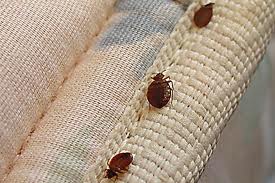 Bedbug will even hide in cracks and crevices on things like furniture, moldings, art, window frames, wall hangings, between floorboards and base boards, in dressers, draws, closets and nightstands, on picture frames, luggage and places you might not even think of like the PHONE, your laptop or even the head of a phillips screw . In short they will hide almost anywhere that provides a safe environment for them to
Bedbug will even hide in cracks and crevices on things like furniture, moldings, art, window frames, wall hangings, between floorboards and base boards, in dressers, draws, closets and nightstands, on picture frames, luggage and places you might not even think of like the PHONE, your laptop or even the head of a phillips screw . In short they will hide almost anywhere that provides a safe environment for them to  wait out the daylight hours.
wait out the daylight hours.
It is absolutely essential that you rid your home of clutter. Bag your luggage and seal it. Check often for the tell tale signs of Bedbugs. You need to be very thorough when looking for Bed Bugs or indications of their presence.
The safest option is to leave it to a professional. They know exactly where to look and what to look for. Cimex Lectulariusis (the Bed Bug) has many stages in it's life cycle and it's appearance can vary greatly. Often the only indications of it's presence are eggs and faeces (droppings) and of course bites on your body and tell tale blood stains on sheets and bedding.
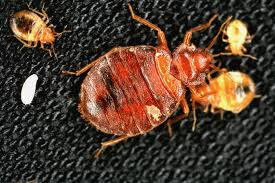 Adult bed bugs are about 1/4th to 1/8th inch long and a blood colored reddish brown, with oval, flattened bodies. Bed Bugs are often mistaken for fleas, ticks and or baby cockroaches. The immature baby bed bugs called bed bug nymphs look like smaller versions of the adults and are translucent or lighter in color. Thank goodness Bed bugs can not fly, but they can run quickly over moldings, bedding, floors, art, walls, ceilings and other surfaces about the speed of an ant in flight mode.
Adult bed bugs are about 1/4th to 1/8th inch long and a blood colored reddish brown, with oval, flattened bodies. Bed Bugs are often mistaken for fleas, ticks and or baby cockroaches. The immature baby bed bugs called bed bug nymphs look like smaller versions of the adults and are translucent or lighter in color. Thank goodness Bed bugs can not fly, but they can run quickly over moldings, bedding, floors, art, walls, ceilings and other surfaces about the speed of an ant in flight mode.
Female bed bugs lay their transparent and translucent eggs in safe harbor areas, depositing as much as up to five a day and nearly 200 to 500 during a lifetime. The bed bug eggs are very tiny, whitish, and hard to see without prior knowledge of what 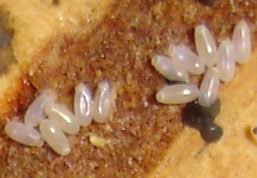 they look like and some kind of magnification is necessary because individual bed bug eggs are about the size
they look like and some kind of magnification is necessary because individual bed bug eggs are about the size 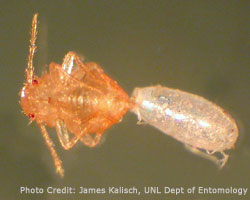 of 2 grains of salt. When the female bed bug first lays her eggs, the bed bug eggs are sticky, causing them to stick to where they are put. Newly hatched bed bug nymphs are no bigger than few grains of salt and they are born with an empty stomach starving for blood. Every time they feed, they molt which means they shed their skin and grow to a new size, they will feed and molt about five times over a 1 to 2 month period before reaching adult bed bug
of 2 grains of salt. When the female bed bug first lays her eggs, the bed bug eggs are sticky, causing them to stick to where they are put. Newly hatched bed bug nymphs are no bigger than few grains of salt and they are born with an empty stomach starving for blood. Every time they feed, they molt which means they shed their skin and grow to a new size, they will feed and molt about five times over a 1 to 2 month period before reaching adult bed bug 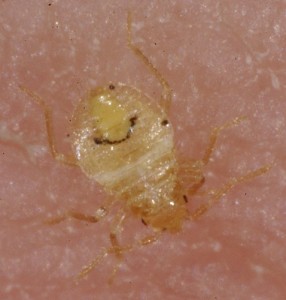 maturity where they will then reproduce and produce about 200 to 500 eggs. As you can surmise, one female bed bug can produce 500 more bed bugs and 500 bed bugs half of which are female or 250 can create another 500 each, doing the math one can see how in one year bed bugs can numerically explode to over a million bed bugs which are epidemic proportions.
maturity where they will then reproduce and produce about 200 to 500 eggs. As you can surmise, one female bed bug can produce 500 more bed bugs and 500 bed bugs half of which are female or 250 can create another 500 each, doing the math one can see how in one year bed bugs can numerically explode to over a million bed bugs which are epidemic proportions.
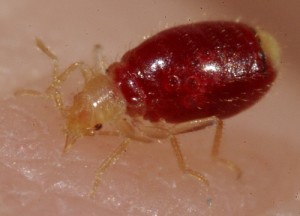 Bed bugs need a blood meal (hematophagia or hematodipsia - blood eating or drinking) to get to their next stage through a molting or shedding of their skin - and will go through 5 or so molts when they finally reach reproductive adulthood. Under favorable summer temperatures and conditions (70 - 90° F), the bugs can complete its adult development in as little as one or two months, producing five or more generations per year. Cold temperatures or limited access to a human or pet blood meal slows down the development cycle of these hardy bed bugs who can go up to or beyond a year without eating. Bed bugs are very resilient and mutate quickly. Bed Bug Nymphs can survive months without feeding and the adults for more than a year making them very difficult to combat unless one uses a long term proactive maintenance program to control them. Bed Bug Infestations are unlikely to decrease just by leaving premises unoccupied, because they will wait patiently and will feed on stray animals, rats and rodents in the mean time if they have access to them. Although Cimex lectularius prefers feeding on humans, it will also bite other warm-blooded animals, including domestic pets or stray animals (like cats) - including rats, mice and rodents.
Bed bugs need a blood meal (hematophagia or hematodipsia - blood eating or drinking) to get to their next stage through a molting or shedding of their skin - and will go through 5 or so molts when they finally reach reproductive adulthood. Under favorable summer temperatures and conditions (70 - 90° F), the bugs can complete its adult development in as little as one or two months, producing five or more generations per year. Cold temperatures or limited access to a human or pet blood meal slows down the development cycle of these hardy bed bugs who can go up to or beyond a year without eating. Bed bugs are very resilient and mutate quickly. Bed Bug Nymphs can survive months without feeding and the adults for more than a year making them very difficult to combat unless one uses a long term proactive maintenance program to control them. Bed Bug Infestations are unlikely to decrease just by leaving premises unoccupied, because they will wait patiently and will feed on stray animals, rats and rodents in the mean time if they have access to them. Although Cimex lectularius prefers feeding on humans, it will also bite other warm-blooded animals, including domestic pets or stray animals (like cats) - including rats, mice and rodents.

